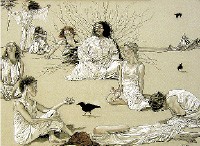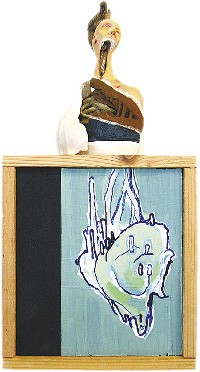In “Le Déluge,” the darkly beautiful exhibition at the Buckman Performing Arts Center, Christine Conley captures the frivolous play of the privileged, the plight of the poor, and a planet careening toward a 21st-century version of the biblical flood.
In the exhibition centerpiece, Après Moi, le Déluge (4-by-8-feet, graphite on styrene), Conley sweeps across time and space with bravura draftsmanship and telling historical detail. On the right-hand side of the drawing, water floods New Orleans’ downtown skyscrapers and pours into residential neighborhoods. Pairs of animals attempting to stay afloat bring to mind Noah and his ark. But in Conley’s apocalyptic vision, instead of finding refuge, the animals spill over the gilded frame.
To the left of the flood waters, Conley transforms Fragonard’s painting The Swing into a drawing as full of lush foliage and elaborate petticoats as the original 18th-century masterwork. The gnarled tree that towers above the nobleman pushing his mistress on a swing twists into tornadic energy that blows through the top of the drawing. And the canopy under which two peasants rest on the opposite side of the flood waters (a detail Conley skillfully appropriates from one of Francois Boucher’s 18th-century pastoral paintings) billows into whirlwinds that burst through the right side of the gilded frame. Unawares, rich and poor alike are about to be swept away. 
She Spoke Softly by David Gillspie
Other works in “Le Déluge” include 70 howling, grimacing faces hanging from the ceiling (Free Agents, ceramic bisque). And in one in a series of five small drawings (Little Boy/The Sleep of Reason), a face peers out of a mushroom cloud created by an atomic explosion. In another, assorted hobgoblins leer at us from Conley’s re-creation of Goya’s The Sleep of Reason Produces Monsters.
A somewhat enigmatic but important part of Conley’s vision hangs on the wall next to the exit. Three retinal-shaped cones, the color and translucency of amber, pierce a black box titled Enlightenment. Like the rest of “Le Déluge,” Enlightenment asks us to look into the dark places in ourselves and our world to realize that our planet careens toward environmental catastrophe and to understand that this time there may be no Noah, no ark, no safe haven.
“Le Déluge” at the Buckman Performing Arts Center through September 15th
Twenty-two artists in Memphis College of Art’s exhibition “Horn Island 22” also explore the raw power of nature. David Gillespie sums up his eight-day sojourn on an uninhabited island with a mixed-media work that is both Eden and a primal scream. In She Spoke Softly, a blue-green heart floats in the center of an acrylic seascape. On top of this painting’s frame sits a beautifully sculpted human torso and head. By Gillespie opening the mouth, throat, and chest of his ceramic work — like Francis Bacon’s screaming, eviscerated portraits — we see humanity inside and out. Unlike Bacon, Gillespie pays homage to life’s beauty as well as its pain.

The Muses Confer by Lisa Tribo
Some of the works reflect Hurricane Katrina’s battering of Horn Island. For example, in Trice Patterson’s spare, close-up drawing Three Sea Oats, the oats look like tall, lean sentinels standing guard on an island that lost many of its trees to Katrina.
Lisa Tribo’s nine women in bright-white gowns on a deserted shore has the look of dreamscape, a post-apocalyptic meeting of survivors at the edge of the earth or a council of goddesses in The Muses Confer (conte on canvas). Tribo’s goddesses do more than muse. They expel the fears that can paralyze; they cleanse themselves with the raw power of nature. One goddess sits with eyes closed, face held up to the sun. Another’s hair is blown back by straight-line winds. With legs apart and arms extended, she thrusts out a staff made of driftwood and performs what looks like an exorcism over another muse who sits on the ground, head buried in her arms.
Other notable artworks include the primordial landscapes Solomon Behnke creates by rubbing coffee, rust, pastel, and paint onto the surface of 150-pound paper. In Landscape/Time, three robed and hooded figures, barely distinguishable from the desert floor and dunes that surround them, walk single-file toward a setting sun. A second sun, burning in the middle of the sky, and points of light, shining above the shrouds, suggest ancient rituals regarding time and matter.
There are few idyllic seascapes in “Horn Island 22.” Many of the works are powerful explorations of nature. Erin Morrison dissolves the boundaries between artist and island. Her surreal self-portrait, Emerge, hints of algae-rich waters and blood-red skies and sea birds. A large eyeball at the center of the painting takes it all in as Morrison’s light-green leg steps out of the primordial pool and plants itself on umber ground at the bottom of the picture plane.
“Horn Island 22” at Memphis College of Art through September 15th